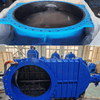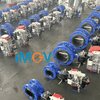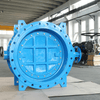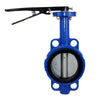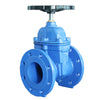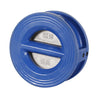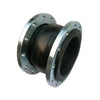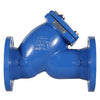Complete Guide to Flange Adaptors for Pipeline Systems
In the world of piping systems, interface compatibility is the foundation for smooth operation. However, reality is often more complex: you may have a high-quality valve or pump with standard flanges, but the pipe you need to connect is a plain-end pipe with an untreated end. Welding? Time-consuming and requires certification. Threading or adding flanges? Complex processes, high costs, and potential delays. This is where a cleverly designed component comes to the rescue—the flange adapter.
What is a Flange Adapter?
In piping and valve systems, a flange adapter is a component used to connect a flanged end to another type of pipe end or fitting.
It is commonly used when the interface forms of two sections of piping or equipment are inconsistent, or when it is necessary to connect a flange to a plain-end pipe without welding or threading.
Structure and Working Principle of Flange Adaptor
- Flange End: Features a standard flange face and bolt holes, allowing direct connection to valves, pumps, or other flanged components.
- Socket/Spigot End: Designed to connect to non-flanged pipes, using a rubber gasket in combination with external clamping bolts and a compression ring to apply radial pressure to the pipe’s outer wall.
This design enables the connection between non-flanged pipes without the need for extensive pipe modifications, allowing for quick installation or removal.
It can not only accommodate a certain degree of pipe movement and slight misalignment, but also maintain sealing and connection strength under pressure, ensuring the stable operation of the pipeline system.

When to Use a Flange Adaptor
Flange adaptors are commonly used in water supply and drainage, municipal water systems, wastewater treatment, irrigation, and industrial pipeline systems. Their core advantage lies in enabling weld-free connections and convenient disassembly. Typical applications include:
- System Modification: Connecting flanged valves to plain-end pipes in newly installed systems.
- Pipeline Repair: When replacing damaged pipe sections, there is no need to cut or weld existing pipe flanges—simply insert the new section into the adaptor’s socket.
- Cross-Standard Connection: Adapting connections between different standards or types.
- Easy Maintenance: In situations requiring frequent inspection or servicing, flange adaptors allow quick removal and reinstallation of equipment or pipe sections, significantly reducing system downtime.
Advantages of Flange Adaptors
- Wide Compatibility – Can connect pipes made of ductile iron, carbon steel, PVC, HDPE, and other materials.
- Easy Installation – No welding, threading, or re-machining of flanges required.
- Convenient Maintenance – Simple disassembly for replacing valves, pumps, or pipe sections, reducing system downtime.
- Reduced Retrofit Costs – Ideal for system upgrades or mismatched interface standards, without major modifications to existing pipelines.
- Cost-Effective – Lowers labor and material costs, suitable for both new installations and retrofit projects.

Difference Between Flange Adaptor and Universal Coupling
Although both can connect pipes of different types or sizes, their functions and structures are not the same:
|
Feature |
Flange Adaptor |
Universal Coupling |
|
Main Function |
Connects a flanged end to a plain-end pipe |
Connects two plain-end pipes (which may have different diameters) |
|
Typical Application |
Connecting valves or pumps to pipelines |
Connecting straight sections of pipe |
|
Sealing Method |
Flange gasket + pipe-end compression seal |
Double-ended compression seal |
|
Bolt Connection |
Flange bolts on one side only |
Clamping bolts on both sides |
In essence, the two are complementary rather than interchangeable — the flange adaptor addresses the “equipment-to-pipeline” interface issue, while the universal coupling handles the “pipeline-to-pipeline” flexible connection requirement. The choice depends on the actual interface type (whether a flange is present) and the system’s needs for pressure rating and movement compensation.

Universal Coupling(wide range)
Flange Adaptor Installation Method
While installation details may vary slightly depending on the manufacturer and pipe material, the basic steps are as follows:
- Preparation – Clean the pipe end and flange sealing surface, removing any sand, rust, or other debris.
- Positioning – Slide the socket end of the flange adaptor onto the pipe, inserting it to the specified depth.
- Align the Flange – Adjust the position so that the flange holes align with the bolt holes of the mating flange.
- Tighten the Flange End – Tighten the flange bolts evenly in a diagonal sequence to the specified torque.
- Secure the Socket End – Tighten the clamping bolts evenly to ensure the sealing ring is uniformly compressed.
- Final Inspection – Check flange alignment, bolt torque, and sealing ring compression, then proceed with pressure testing.
Correct installation ensures the flange adaptor achieves optimal sealing performance and service life during operation.
Summary
A flange adaptor is a simple yet highly practical connection solution, enabling efficient connection between flanged equipment and plain-end pipes. It is particularly suitable for water and industrial systems that require quick installation, reduced downtime, and flexible modification.
By understanding its structure, advantages, and correct installation method, you can improve the reliability of your pipeline system and reduce maintenance costs.
As a long-standing manufacturer in the water and industrial valve sector, Union Valve is committed to providing high-quality flange adaptors and matching valve solutions to customers worldwide, helping projects achieve the ideal balance between safety, reliability, and cost-effectiveness.If you have further questions, please contact us.


